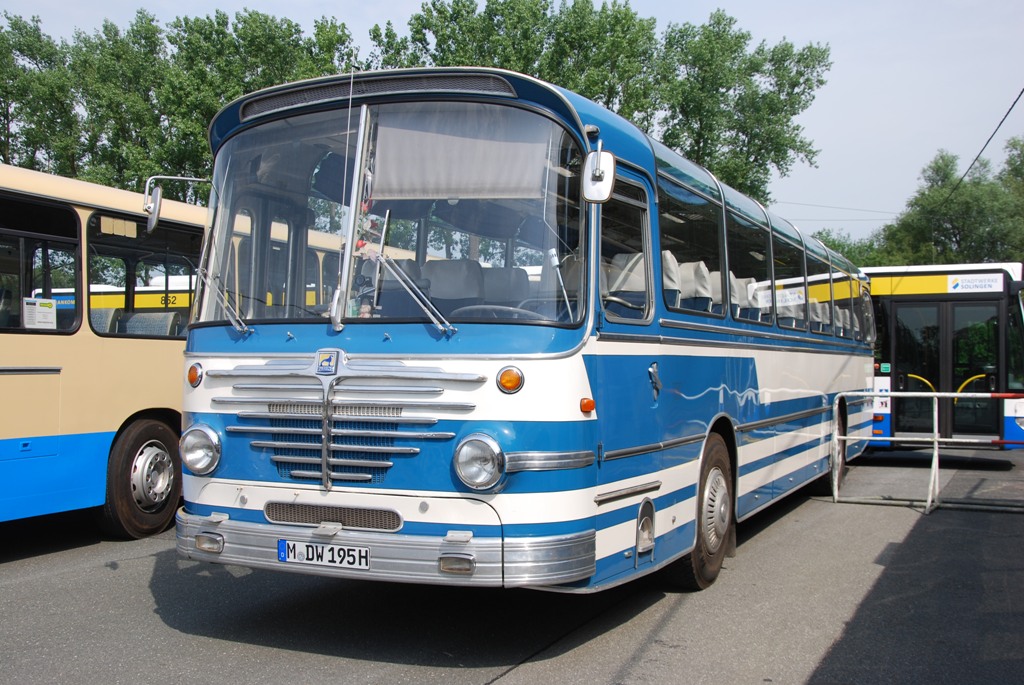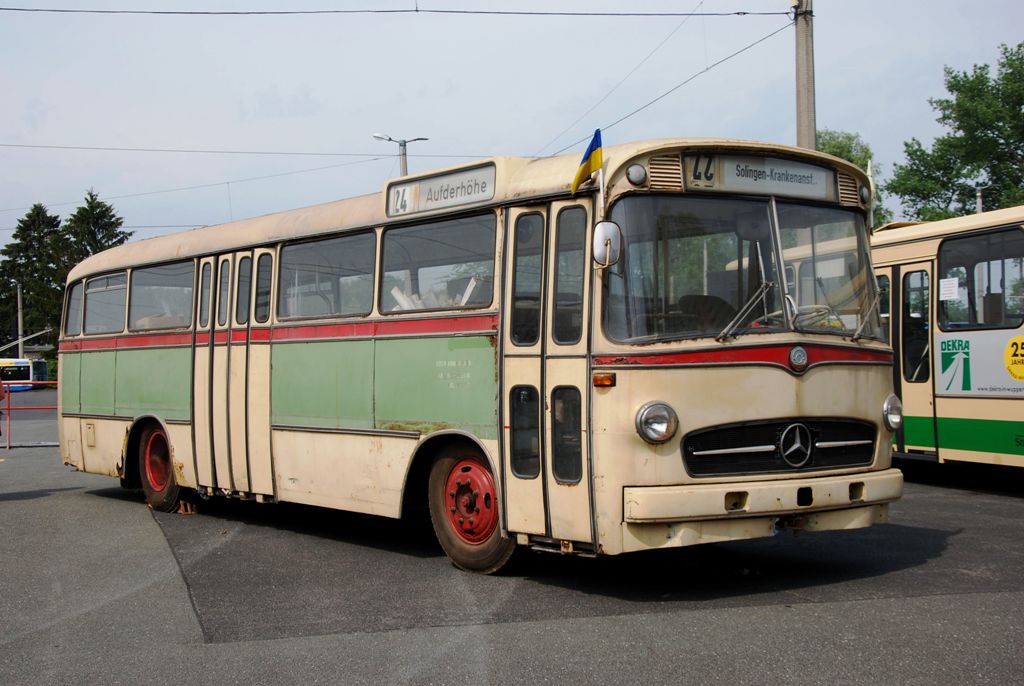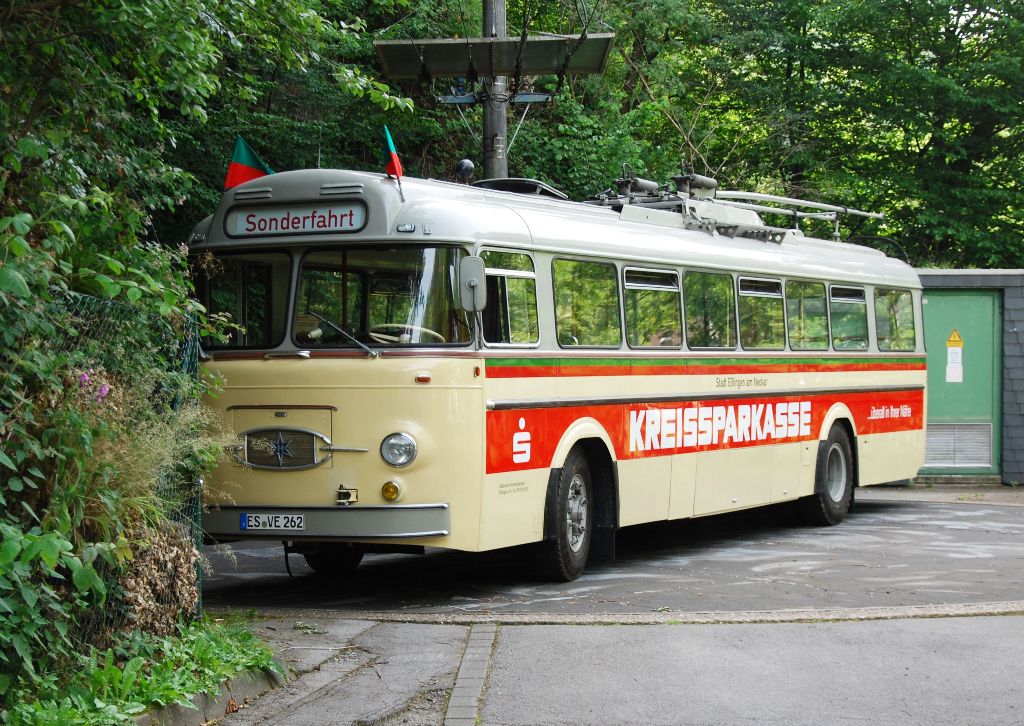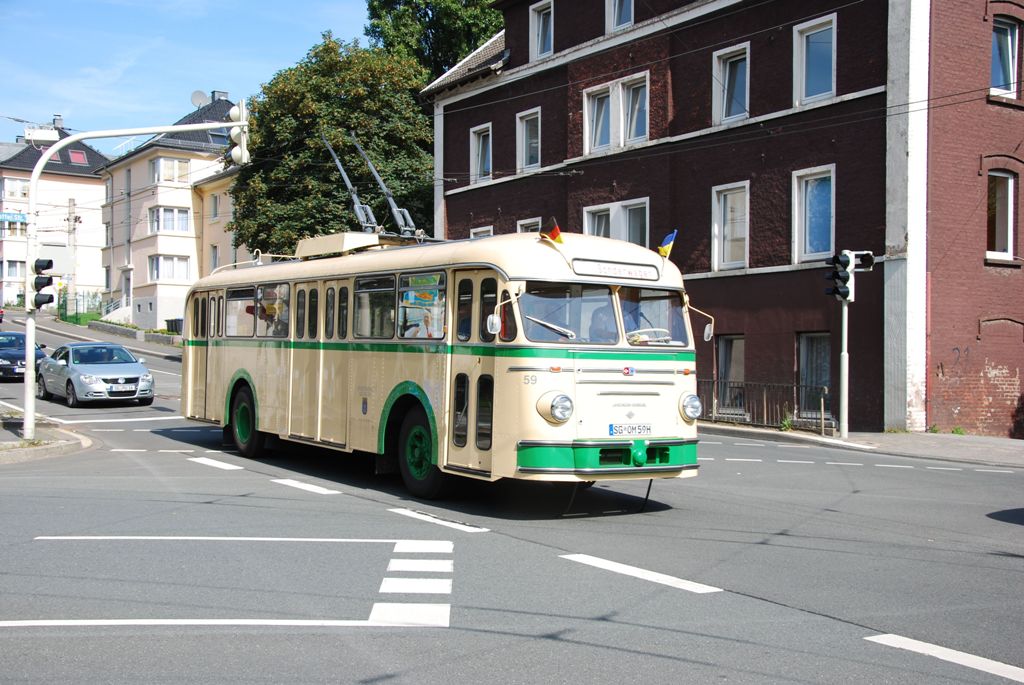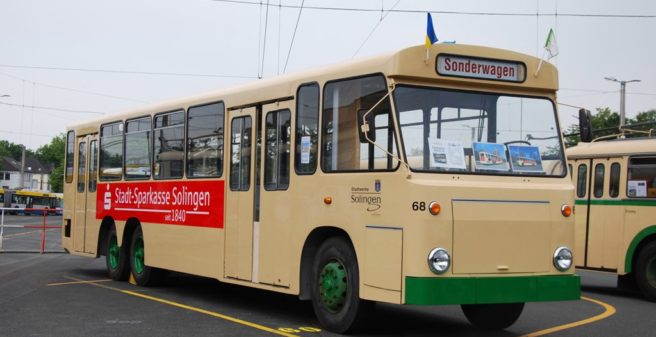
From tramway to trolleybus
In 1896 Solingen opened its tramway which gradually grown. During the Second World War, the network suffered severe damage. Reconstruction and conversion of the entire network to double-track operation was estimated at 10 million DM in 1950, so the lines were only “provisionally” restored and alternatives to the tramway were considered.
The first diesel bus lines started in the 1920s, some of which were operated by the SWS’s contracting company Wiedenhoff (a well-known private company from Leichlingen-Witzhelden and Solingen).
Switch to trolleybuses
At the beginning of the 1950s, the city council decided to discontinue tram operation and to introduce trolleybuses. Despite the equally high costs for the installation of the oberhead, the trolleybus was considered to be significantly cheaper than the tramway, the low operating costs, the low costs for the “fuel” (electricity produced by the municipal utilities themselves) and the long service life of the buses speak in its favour.
On 19 June 1952 Solingen’s first trolleybus line started operation, between Graf-Wilhelm-Platz via the town hall and the district of Mangenberg to Ohligs station (today’s main station). The fact that today’s main station was still called Bahnhof Ohligs at that time has historical reasons: When the tram was opened, Ohligs was not yet part of Solingen, but was an independent town. There used to be a main station in Solingen, located on the branch line from Ohligs over the famous Müngsten Bridge to Remscheid between Kölner Straße and Brühler Straße. No trains have stopped here for a long time because of its location quite distant from the main urban areas, a new stop was created approximately one kilometre away but closer to the city centre – called “Solingen Mitte”.
Solingens erste Obusse: Uerdingen ÜH III s
Solingens erste Obusse waren vom Typ „Uerdingen ÜH III s“. Sie waren selbsttragend, deshalb das kleine nachgestellte „s“ in der Typenbezeichnung, und verwendeten Komponenten von Henschel. Weshalb sie auch gerne, wenn auch eigentlich fälschlich, als „Henschel/Uerdingen ÜH III s“ bezeichnet werden. Nach deutschem Zulassungsrecht indes gilt der Hersteller des Fahrgestells als Hersteller des Fahrzeugs, und weil ein selbsttragender Bus kein Fahrgestell hat, ist eben der Hersteller des gesamten Wagenkastens der Hersteller des Busses. Und die Wagenkästen waren von Uerdingen. Solingens erste Trolleybusse waren die Wagen 1 bis 6 vom Jahrgang 1952. Anmerkung: als Ende der sechziger Jahre die ersten Wagen der zweiten Generation an die SWS ausgeliefert wurden und zudem gebrauchte Obusse aus Minden und Bochum übernommen wurden, wurde unter den ÜH III s teilweise ganz munter umgenummert. So wurde zum Beispiel aus dem ursprünglichen Wagen 1 zunächst Wagen 6 und dann auch noch Wagen 46, als Wagen 01 erschien jetzt der ehemalige Wagen 101 der Elektrizitätswerke Minden – Ravensberg, auch er ein Uerdingen ÜH III s.
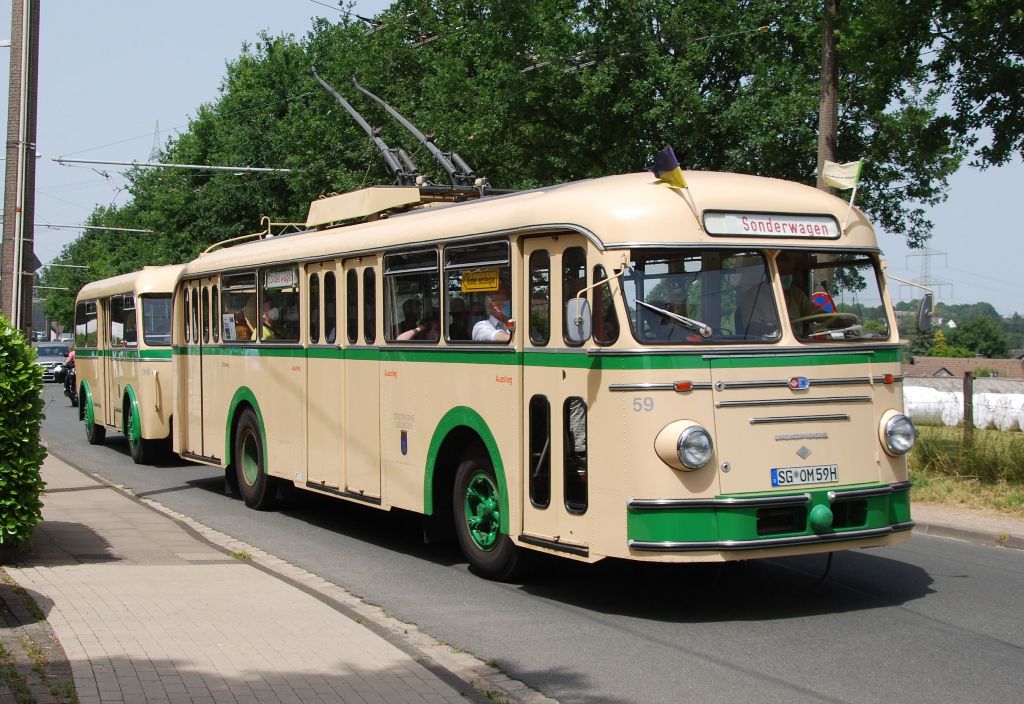
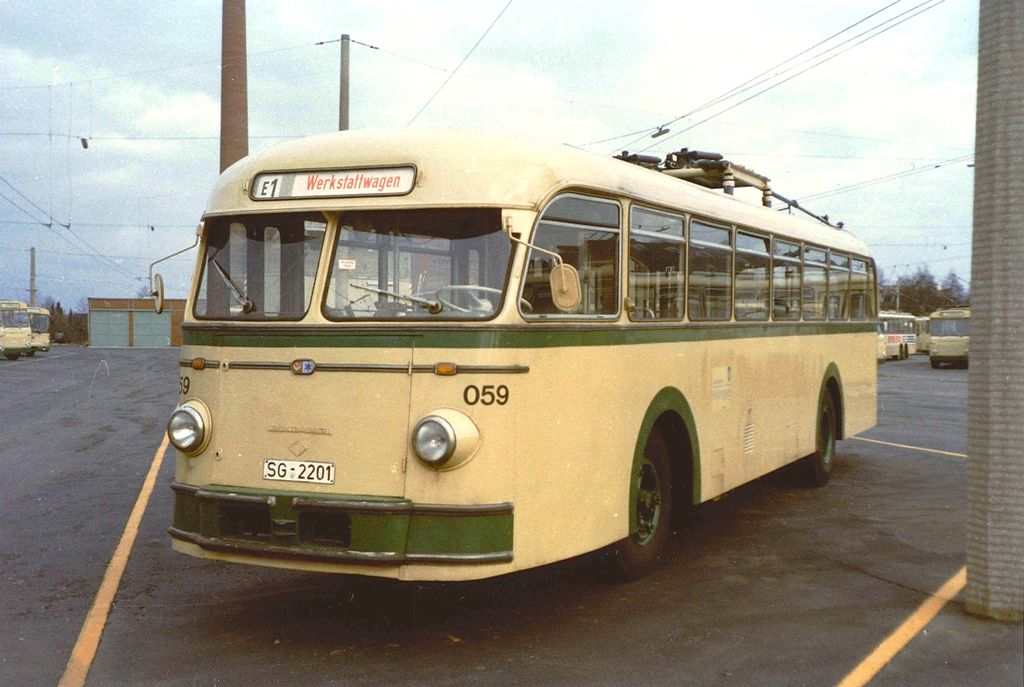
Network extensions
In 1953, the so-called “Solingen trolleybus ring” was created, which is formed by today’s Solingen lines 681 and 682. First it went from Ohligs station to the district of Wald (line 2), shortly afterwards line 2 continued from Wald via “Central” to the town hall, and thus the ring was closed. The trolleybuses could now continue under the already existing overhead line of line 1 to Graf-Wilhelm-Platz, the central stop for Solingen’s trolleybuses in the inner city. For the network extension 14 more ÜH III s (no. 7 to 20) were purchased.
Three years after the opening of the trolleybus service, on 15 June 1955, line 2 (today 682) was extended from Graf-Wilhelm-Platz to Höhscheid, two months later line 1 (today 681) from Graf-Wilhelm-Platz to Hästen. In 1957, after five years of trolleybus operation, the originally 4.6-kilometre-long Line 4 from Graf-Wilhelm-Platz via the Werwolf stop to the school in the Widdert was added. On 31 May 1981 it was extended from Graf-Wilhelm-Platz to Hasselstraße, a new urban development area in the eastern part of the city.
On 7 October 1958, line 3 (today 683) finally followed from Graf-Wilhelm-Platz via Central to Vohwinkel Schwebebahn (suspension railway) terminus in the neighbouring city of Wuppertal. And on 2 December 1959 the Solingen trolleybus network reaches its greatest extension for a longer period of time with the extension of line 3 (683) in the opposite direction from Graf-Wilhelm-Platz via Krahenhöhe (with an intermediate reversing loop) to Burg an der Wupper. Line 3 thus crosses the Solingen city limits at both ends: Burg (with the well-known castle of the Dukes of Berg) was still an independent municipality at that time – it was incorporated into Solingen on 01 January 1975 -, Vohwinkel has been a district of Wuppertal since 1929 founded at that time as a merger of the towns and municipalities of Barmen, Beyenburg, Cronenberg, Elberfeld, Ronsdorf and Vohwinkel. There was no connection to Wuppertals’s own trolleybus system which mainly served the districts of Elberfeld, Barmen and Ronnsdorf. But although Wuppertal stopped its trolleybus service on 27 May 1972, it is still one of the five German cities where trolleybuses can be seen on the streets, thanks to the Solingen line 683: Eberswalde, Esslingen, Solingen, Wuppertal (the Solingen line 683) and Stuttgart (the Esslingen line 101). Ten more ÜH III s were supplied, numbered 53 to 62. This marked the end of the procurement of brand-new ÜH III s in Solingen. Trolleybuses 63 (ex Bogestra Bochum 5) and 01 to 04 (ex Elektrizitätswerke Minden – Ravensberg 101, 105, 103 and 104), all of them also of the type ÜH III s, were still being purchased.
From 1960 to 1962, the SWS bought six 12-metre Henschel trolleybuses, model HS 160 OSL (no. 64-69) and Henschel articulated trolleybuses, model HS 160 OSL-G (no. 70-75). These twelve trolleybuses actually neither belonged to the first nor to the second generation of Solingen trolleybuses. And the articulated trolleybuses were to remain the only articulated trolleybuses in Solingen for a long time.
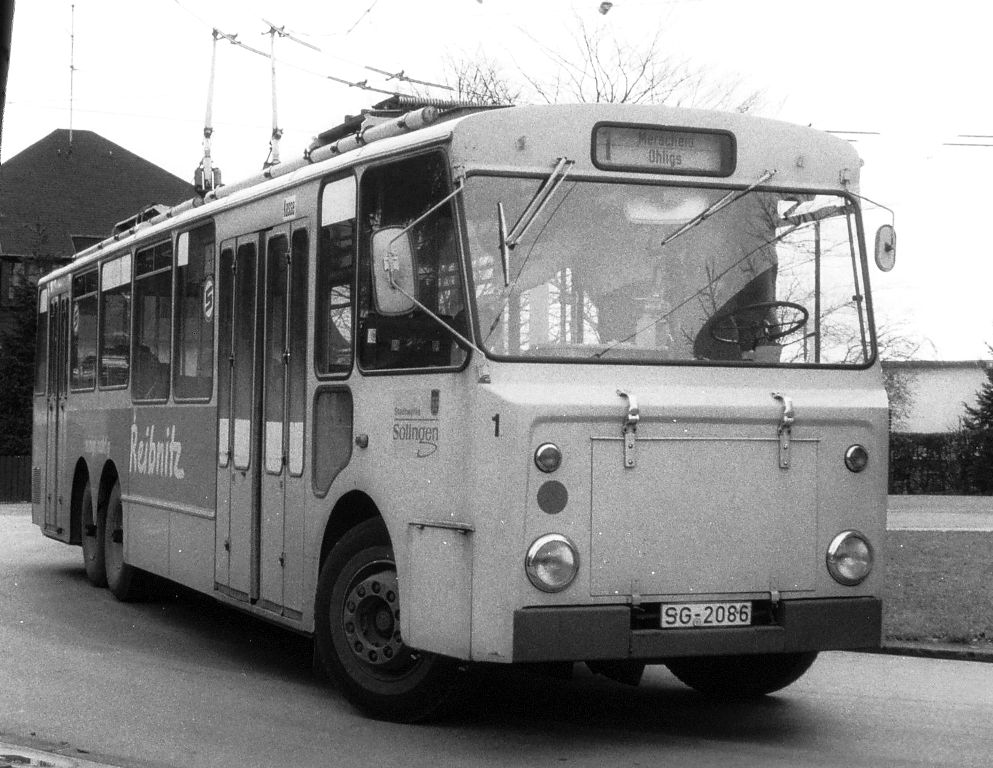
Solingen’s second trolleybus generation: the legendary TS
At the end of the sixties Solingen’s oldest trolleybuses were 16 years old. The then head of the Solingen public utility company, Dipl.-Ing. Meis, found the concept of the three-axle Italian “filo buses” (literally: wire buses) very convincing, and as no manufacturer in Germany offered such a product, he designed the trolleybus himself. The trolleybuses were fitted with chassis from Krupp (where vehicle construction had actually already ceased) were fitted with bodies by Gebr. Ludewig in Essen. The SWS installed the electrical equipment in their own workshop by using second-hand equipment from the old ÜH IIIs and the twelve Henschels and “transplanting” it into the new trolleybuses.
The vehicles looked unusual: the front axle was at the very front of the bus, the driver sat above it in what was basically a completely separated driver’s cabin. The wide front door was allocated just behind the front axle. If the driver had to sell tickets, he had to turn his seat almost 180 degrees in order to “communicate” with the passenger. The TS were driven on axles 2 and 3 – to enable better performance especially during harsh winter weather not uncommon in the area around Solingen.
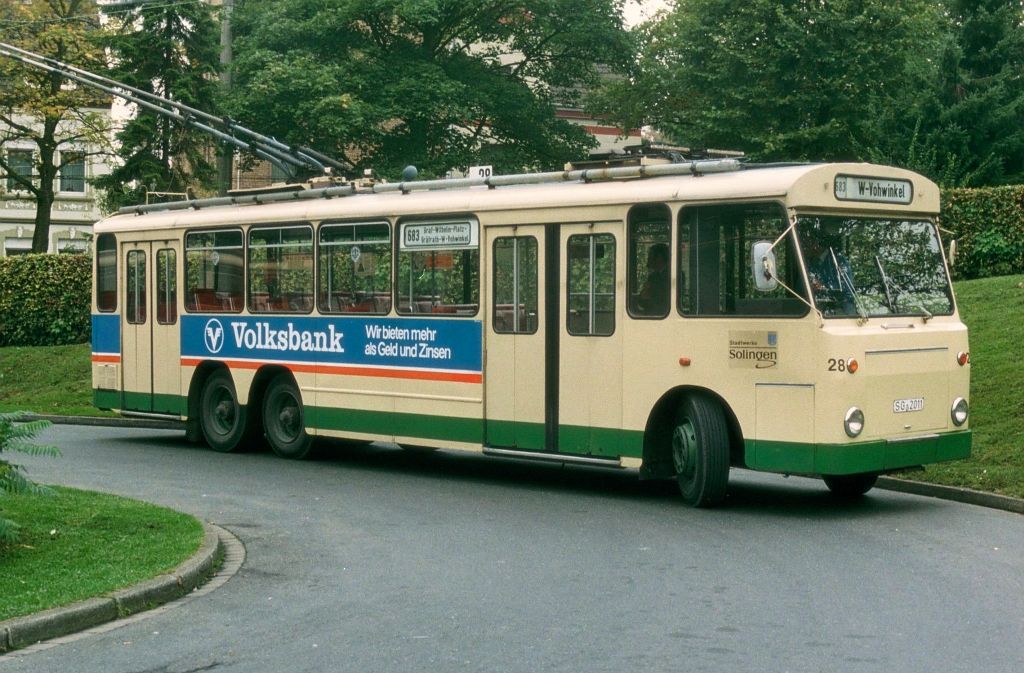
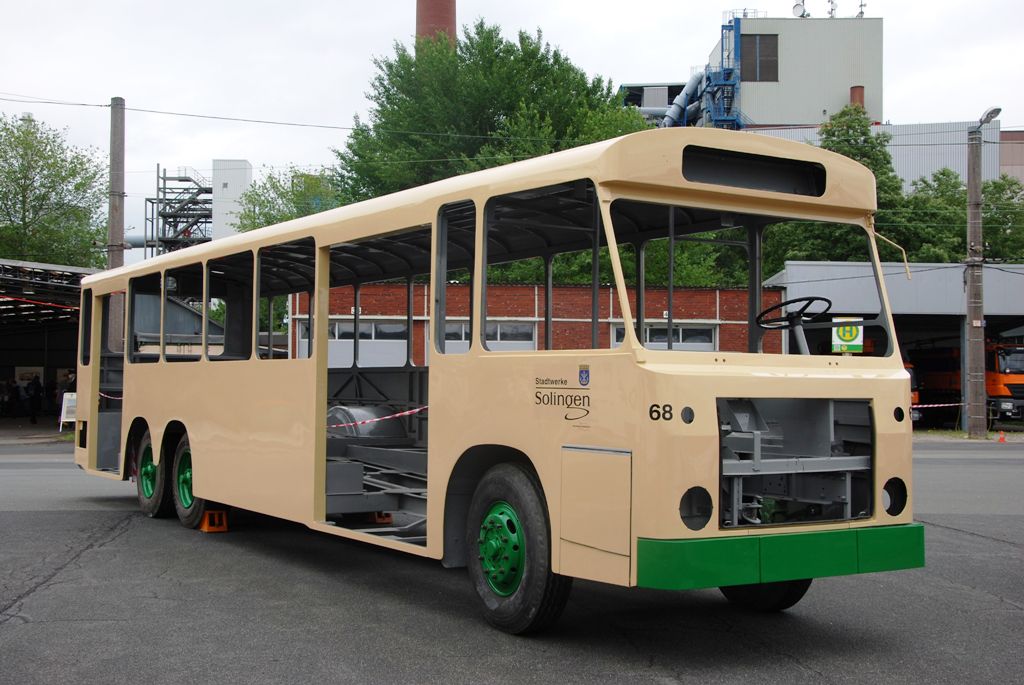
The twelve-metre-long trolleybuses could carry an unusually large number of passengers: 28 seats compared to 124 standing room seats. On the other hand, a passenger capacity of 152 is truly remarkable for a 12-metre bus. In the area of the wide front door there was a large (low-floor) platform without any seating, in the higher rear area of the coach the seats were arranged according to the scheme 2 + 1: two seats on the left side of the coach next to each other, on the right side of the coach single seats. In other words, a wide aisle – with plenty of space for standing passengers.
The trolleys were designated TS – for “Trolleybus Solingen”. There were three series: the TS 1 no. 1 (the prototype from 1968) to 14 from 1969, the TS 2 from 1970 to 1972 (no. 15 to 45) and the TS 3 from 1972 to 1974 (no. 46 to 80).
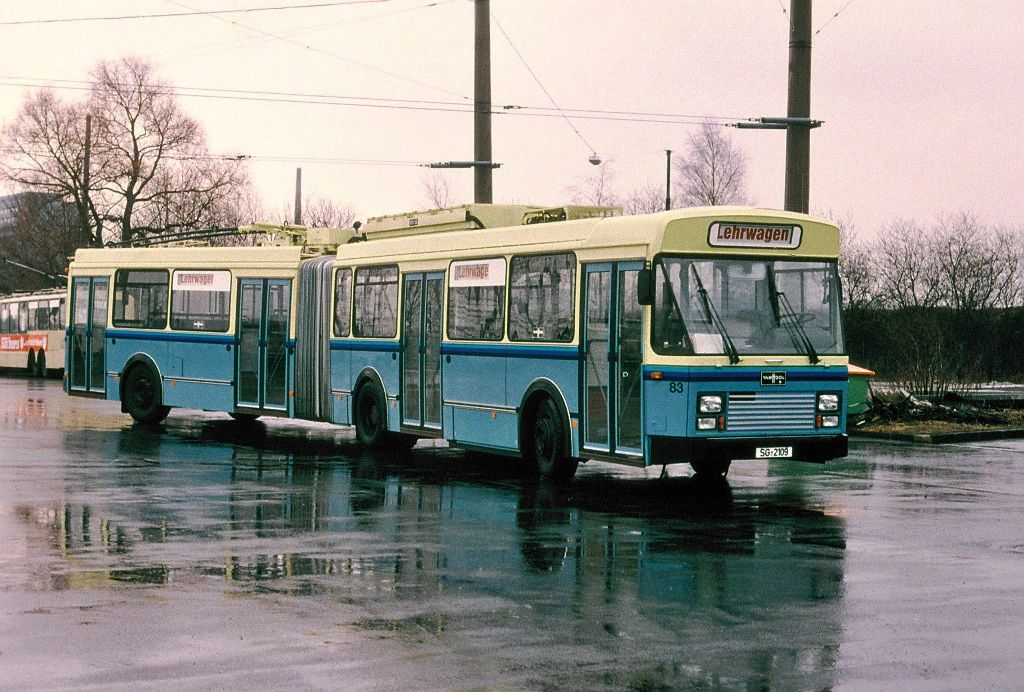
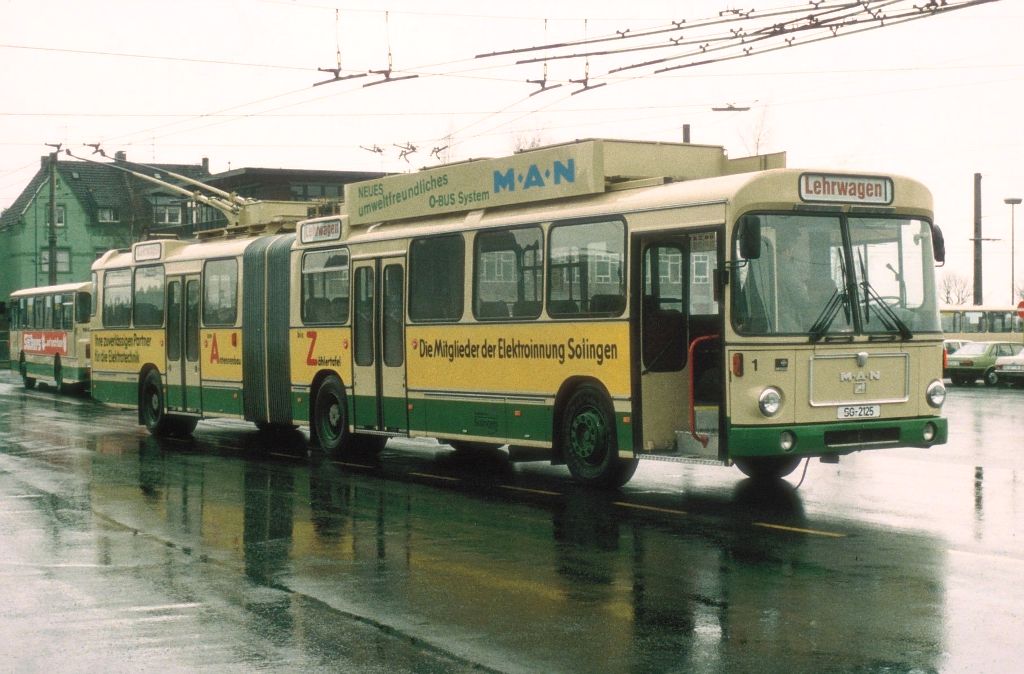
MAN’s third generation
Solingen’s third generation of trolleybuses entered service from 1982 on. After testing trolleys from various manufacturers (among others, a Czech Skoda and an articulated trolleybus from the Swiss capital Bern did their test rounds in Solingen), the supplier chose MAN.
MAN had not been building trolleybuses in Germany for a long time. But they had their factory in Vienna for special orders – with the renowned name “Gräf & Stift”. Solingen’s trolleybuses of the third generation were therefore built by Gräf & Stift, but were officially considered products of the German MAN and also had German vehicle identification numbers (beginning with “WMA” – i.e. “W” for Germany and “MA” for MAN). There were 21 articulated trolleybuses of the type MAN SG 200 HO (no. 1 to 21) and 46 rigido trolleybuses with a length of 12 metres of the type MAN SL 172 HO with the car numbers 22 to 67. In terms of seating and drive, the three-axle trolleybuses followed the example of their predecessors of the TS type, but they were now three-door trolleybuses. Among the articulated trolleybuses, wagon 7 died at a very young age – it was replaced by a new one that was delivered later and was again given the wagon number 7. It was a good coincidence: at the factory in Vienna-Liesing a few articulated trolleybuses of this type were under construction for Bergen in Norway, so the replacement coach for Solingen could simply be attached.
The three-axle MAN trolleybuses allowed the conversion of two diesel bus lines between Graf-Wilhelm-Platz and the Aufderhöhe district (on different routes) to trolleybus operation – the trolleybus lines 685 and 686. Thus, Solingen’s trolleybus network has basically reached its greatest extent ever. During the conversion of diesel bus line 695 to BOB (battery trolleybuses), a few metres of overhead line were added at Unionstraße – it may be just 50 metres.
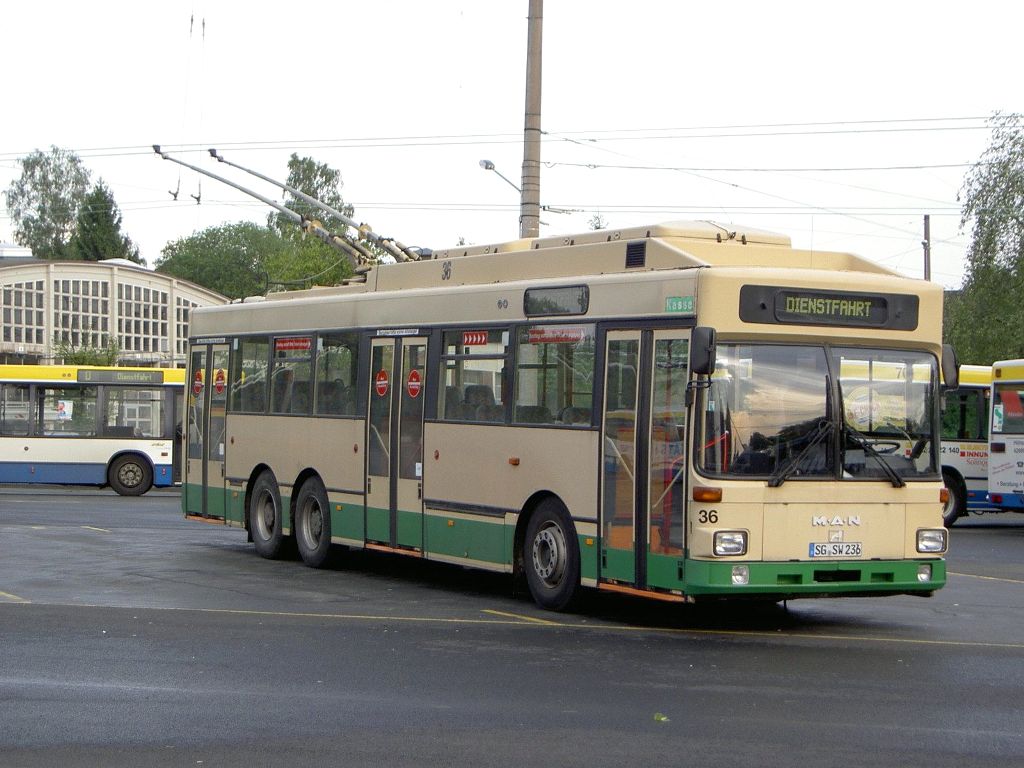
Joint orders with GVA Arnhem
At the beginning of the new millennium, the fourth generation of trolleybuses came to Solingen. Together with the GVA in Arnhem (Gemeente Vervoerbedrijf Arnhem) 15 articulated trolleybuses of the Dutch type Berkhof Premier AT 18 (cars 171 to 185) were ordered in 2001 and 20 articulated trolleybuses of the type Van Hool AG 300 T (cars 251 to 270) from Belgium in 2002. At the Open Day, many good things were said about the Berkhof: their floor groups are made of a material that does not rust.
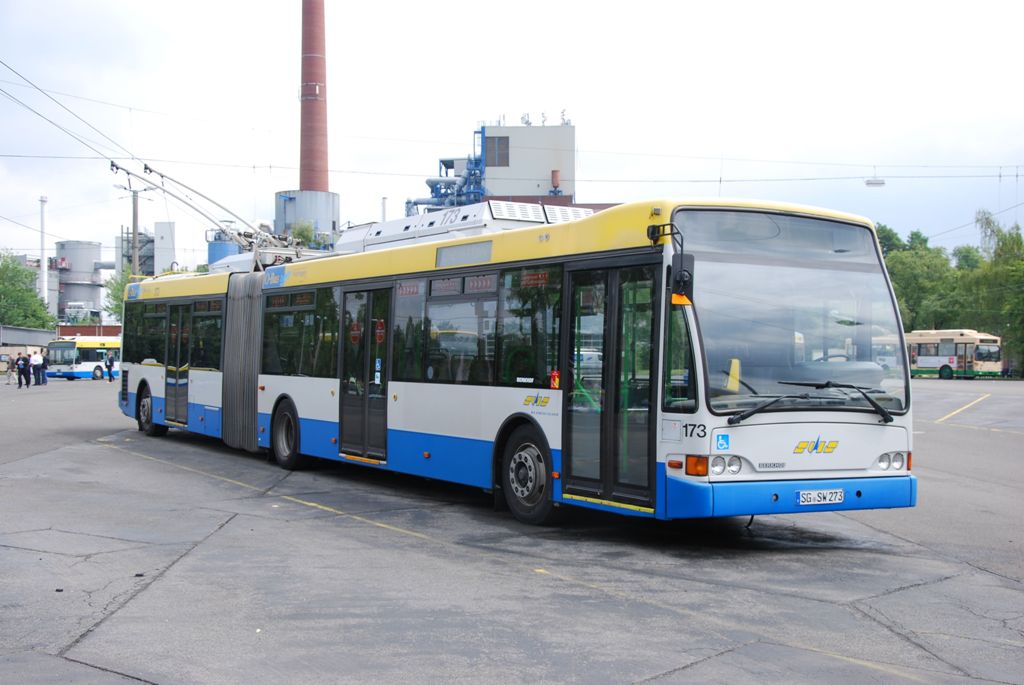
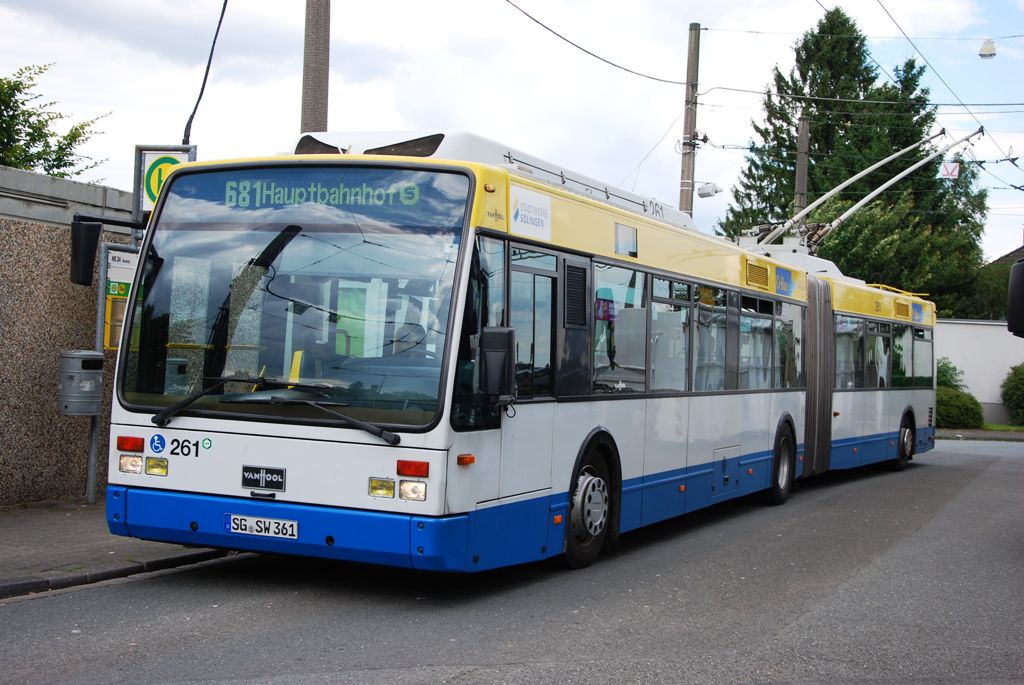
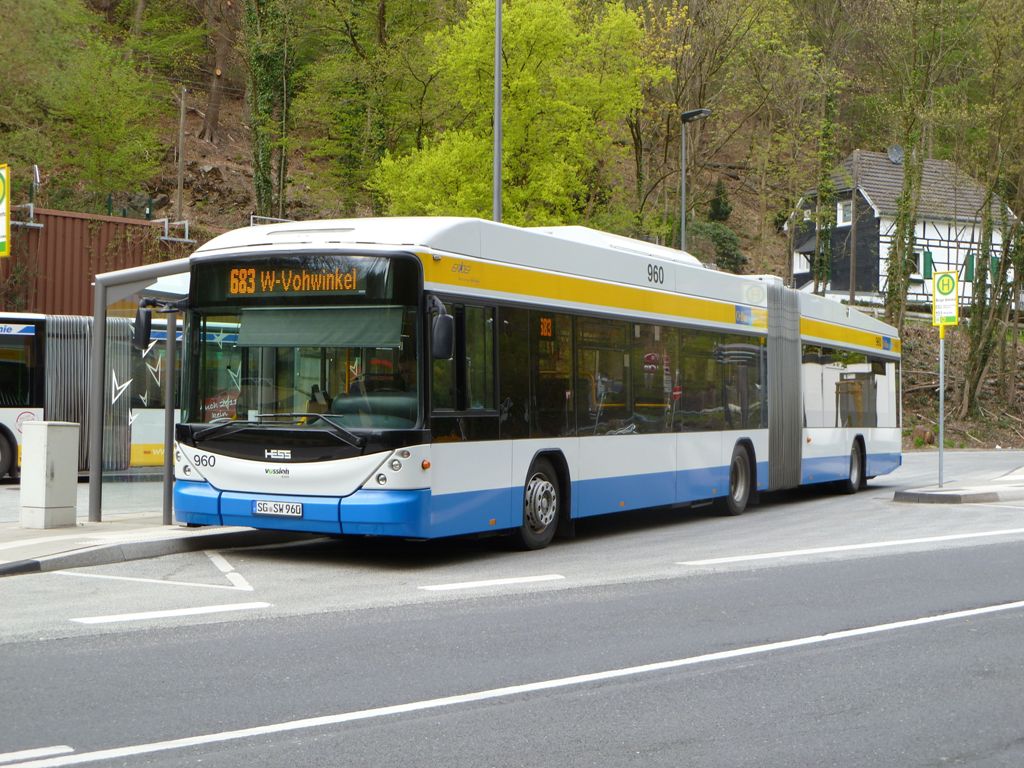
Hess with diesel generator from Kirsch
In 2009, SWS broke new ground. They purchased 15 Hess BGT-N 2 C articulated trolleys with the numbers 951 to 965 (BGT = Bus Articulated Trolley, N = low-floor, 2 = driven on two axles) from the Swiss manufacturer Hess. The special feature of these trolleys is that they can not only run under the overhead line, but that they have “auxiliary driving equipment” made by the Trier company Kirsch: a diesel generator provides the electricity that allows the bus to run electrically even in sections of the line without overhead lines. This made it possible to extend line 683 at both ends without having to install new overhead lines: in Burg from the turntable to the “Burger Bahnhof” (although the days when a railway used to run there are long gone), in Wuppertal from the Vohwinkel suspension station to the Vohwinkel station of the big railway. Especially in Vohwinkel it would not have been possible to install a trolleybus overhead line because of a very low railway subway, and in Burg they did not want an overhead line in order not to spoil the image of the historic town centre.
The battery trolleybus (BOB)
Which brings us almost to the end of “70 years of trolleybuses in Solingen”. In 2018, the Solingen SWS introduced its first “BOB” (Batterie-Oberleitungsbus) – the Solaris model “Trollino 18.75 BOB”. It is a trolleybus that can run under and with the trolleybus overhead line, but also only with the electricity from its batteries. And with this trolleybus, one not only breaks away from the diesel bus, but also from the pure trolleybus, which always and everywhere needs an overhead line. In the medium term, SWS plans to fully electrify all of its bus lines – battery trolleybuses will run on all major sections, where they can recharge their batteries under the overhead line on sections of the route without any loss of time for charging. Today, SWS has eight “Solaris Trollino 12 BOB” (solo cars, cars 201 to 208) and 12 “Solaris Trollino 18 BOB” (articulated cars, service numbers 861 to 872). One thing, by the way, is interesting in connection with the BOB: they can do 70% of their running with electricity from their batteries and thus only need an overhead line on 30% of their route.
Solingen has always been one of the largest German trolleybus operators – apart from the very early days. Today – after almost all trolleybus operations have been discontinued – it is unchallenged in the largest operator.
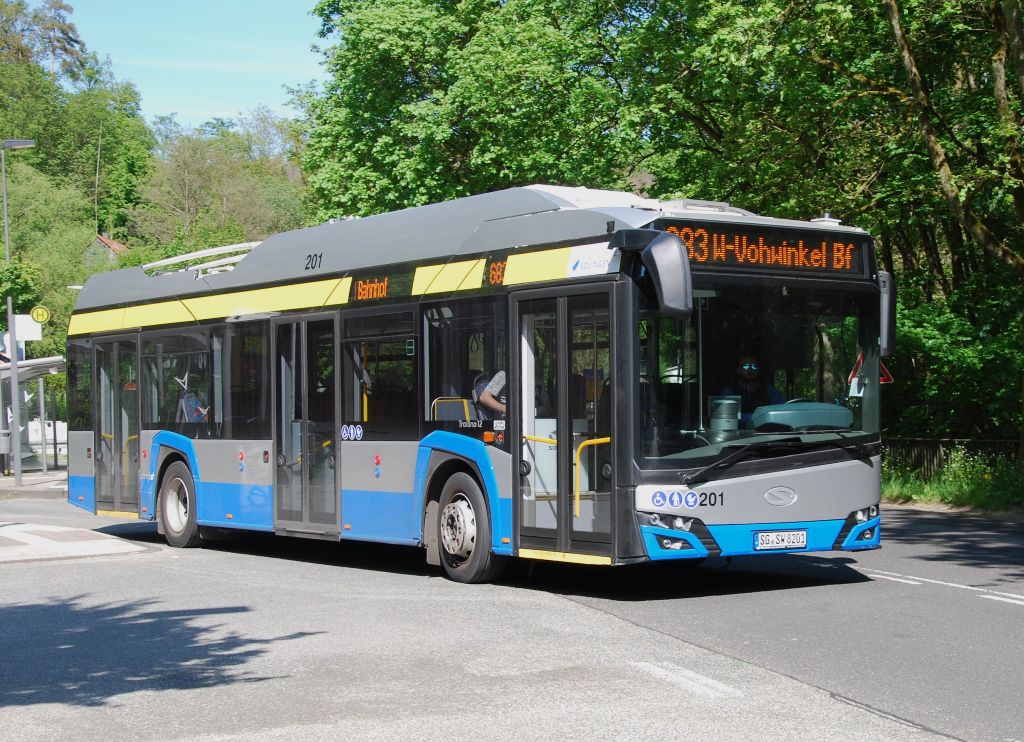
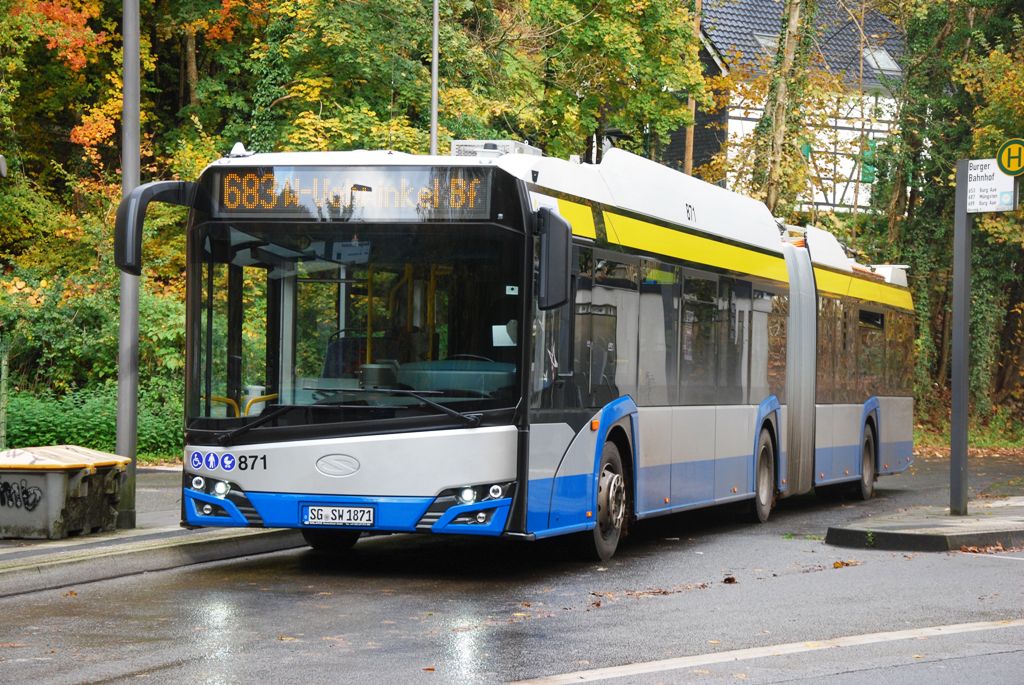
The Anniversary “70 Years of Trolleybuses
On the weekend of 18 and 19 June 2022 the anniversary “70 years of trolleybuses in Solingen” was celebrated. It was a good coincidence that on 19 June 1952, exactly 70 years ago, Solingen’s first trolleybus line 1 between Graf-Wilhelm-Platz and the (then) Ohligs station had started revenue service. The anniversary was celebrated on Saturday with rides on historic trolleybuses of the local heritage association “Obus-Museum Solingen e.V.” and on Sunday with an open day at depot Weidenstraße, which not only offered an overview of all generations of Solingen’s operation, but was also attended by a few “guest buses” from outside. A Büssing/Emmelmann Senator 15 from Munich had the longest journey. And with it there was probably also an absolute premiere: it can be assumed that before it a coach had never been turned around on the famous trolleybus turntable in Burg. A second diesel old-timer had come from neighbouring Bochum; however, it originally came from Regionalverkehr Hannover and was called “H-AP 107” there. SWB car 2035, a Solaris Urbino 18 electric, had made its way from Bonn: it had found a hidden place at the depot in Solingen.
Two trolleybuses had also travelled to Solingen from outside: Esslingen’s no. 22, a Henschel HS 160 OSL from 1962, and SWT Trier’s no. 28, another Henschel from 1962, but in the articulated version as HS 160 OSL-G model. The Henschel from Trier has a special feature: when the trolleybus service in Trier was discontinued on 25 May 1970six trolleybuses were much too young to be scrapped. Therefore, the municipal operator converted them into diesel buses with Büssing U 10 motors. They survived almost 30 years, and no. 28 has been kept as a historic bus. In the meantime, it has also been fitted with trolley booms again, but just for demonstration purposes, because of course it is still a diesel bus today.
The guest trolleybuses were on special trips on Saturday: Trier 28 ran – together with the Solingen ÜH IIIs no. 59 + Orion trailer 06 – on line 681 to Hästen, Esslingen’s 22 was together with the Solingen MAN no. 42 on line 683 to the turntable an Burg/Brücke.

